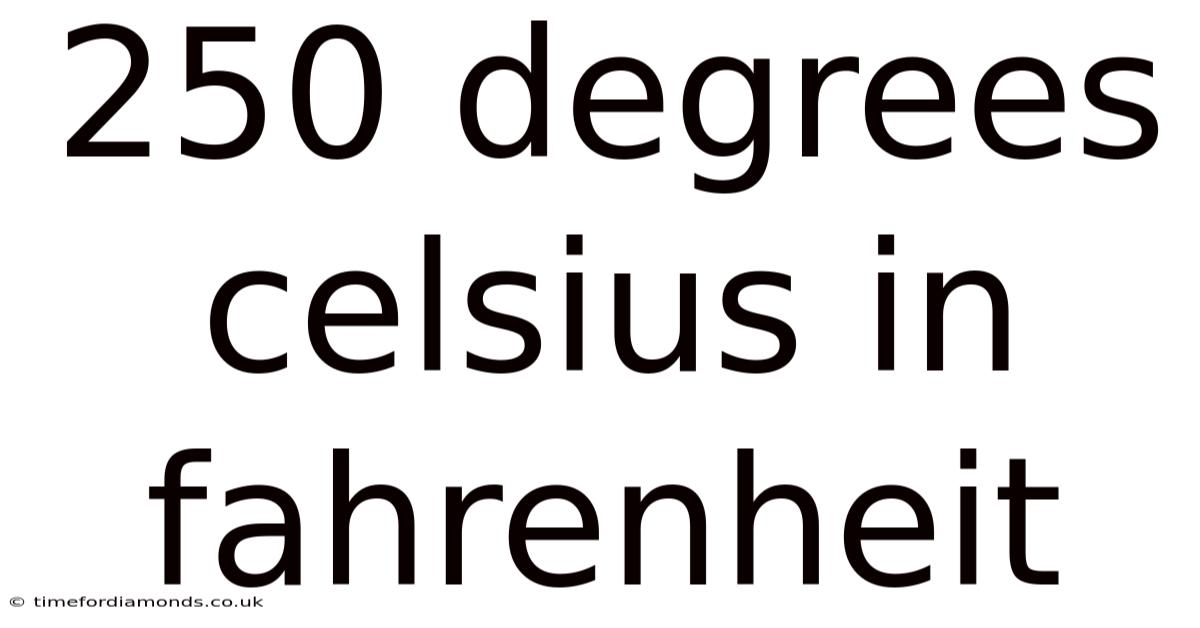250 Degrees Celsius In Fahrenheit
timefordiamonds
Sep 24, 2025 · 5 min read

Table of Contents
250 Degrees Celsius in Fahrenheit: A Comprehensive Guide
Converting Celsius to Fahrenheit is a common task for anyone working with temperatures, whether it's checking a recipe, understanding weather reports, or working in a scientific setting. This article will delve deep into the conversion of 250 degrees Celsius to Fahrenheit, exploring the underlying formula, its applications, and providing a comprehensive understanding of temperature scales. We’ll also address frequently asked questions and explore the practical implications of this specific temperature.
Understanding Temperature Scales
Before diving into the conversion, let's briefly understand the two most commonly used temperature scales: Celsius (°C) and Fahrenheit (°F).
-
Celsius (°C): Also known as the centigrade scale, it's a metric unit based on the freezing and boiling points of water. Water freezes at 0°C and boils at 100°C at standard atmospheric pressure.
-
Fahrenheit (°F): This scale is predominantly used in the United States. Water freezes at 32°F and boils at 212°F at standard atmospheric pressure. The scale was originally based on a mixture of ice, water, and ammonium chloride.
The Conversion Formula
The formula to convert Celsius (°C) to Fahrenheit (°F) is:
°F = (°C × 9/5) + 32
This formula tells us that to convert a Celsius temperature to Fahrenheit, we first multiply the Celsius temperature by 9/5 (or 1.8), and then add 32.
Converting 250°C to Fahrenheit
Now, let's apply the formula to convert 250°C to Fahrenheit:
°F = (250°C × 9/5) + 32
°F = (450) + 32
°F = 482
Therefore, 250 degrees Celsius is equal to 482 degrees Fahrenheit.
Applications of 482°F (250°C)
A temperature of 482°F (250°C) has various applications across different fields:
-
Cooking: This temperature is commonly used in ovens for baking and roasting. Many recipes call for high heat to achieve a crispy crust or properly brown food items. For example, baking bread often requires temperatures in this range.
-
Industrial Processes: Many industrial processes, particularly those involving metalworking, require temperatures around 250°C. This could include heat treating metals to alter their properties, or processes like forging and annealing.
-
Scientific Experiments: In scientific research and experiments, this temperature might be used in various contexts, depending on the experiment's requirements. This could be for chemical reactions, material science experiments, or biological studies requiring elevated temperatures.
-
Home Appliances: Some home appliances, such as certain types of toasters or specialized ovens, may reach temperatures close to 250°C.
Safety Precautions at High Temperatures
Working with temperatures as high as 482°F (250°C) necessitates stringent safety precautions:
-
Appropriate Personal Protective Equipment (PPE): Always wear heat-resistant gloves, oven mitts, and eye protection when working with high temperatures. Protective clothing might also be necessary depending on the application.
-
Proper Ventilation: Ensure adequate ventilation in the work area to avoid inhaling any fumes or harmful substances that might be released at such high temperatures.
-
Fire Safety: Keep fire extinguishers readily available and be aware of fire safety procedures. Never leave high-temperature appliances unattended.
-
Awareness of Material Properties: Be aware of the melting points and other properties of materials used at these temperatures. Improper materials could melt or cause other safety hazards.
Understanding Heat Transfer
At 250°C, heat transfer is significant. Understanding the modes of heat transfer – conduction, convection, and radiation – is crucial for managing and controlling temperatures at this level.
-
Conduction: Heat transfer through direct contact. Materials with high thermal conductivity will transfer heat more efficiently than those with low conductivity.
-
Convection: Heat transfer through the movement of fluids (liquids or gases). Hot air or liquid rises, carrying heat away from the source.
-
Radiation: Heat transfer through electromagnetic waves. Objects at high temperatures emit infrared radiation, which can heat surrounding objects.
Different Temperature Scales: A Wider Perspective
While Celsius and Fahrenheit are the most prevalent, other temperature scales exist, including Kelvin (K) and Rankine (R). Kelvin is the absolute temperature scale, where 0 K represents absolute zero, the theoretical point where all molecular motion ceases. Rankine is an absolute scale based on Fahrenheit degrees.
Converting to Kelvin is important in many scientific and engineering applications. The formula is:
K = °C + 273.15
So, 250°C is equal to 523.15 K.
Frequently Asked Questions (FAQs)
- Q: Is 250°C a high temperature?
A: Yes, 250°C (482°F) is considered a high temperature and requires careful handling and safety precautions.
- Q: What happens to water at 250°C?
A: Water boils at 100°C at standard atmospheric pressure. At 250°C, water would be a superheated steam, with significantly higher pressure and energy.
- Q: Can I use a standard oven thermometer at 250°C?
A: Most standard oven thermometers are capable of measuring temperatures up to 250°C, but check the thermometer's specifications to ensure its accuracy and safety at this temperature.
- Q: Why is the conversion formula important?
A: The conversion formula is crucial for ensuring accurate communication and data analysis across different regions and scientific fields that utilize different temperature scales.
Conclusion
250 degrees Celsius, equivalent to 482 degrees Fahrenheit, represents a significant temperature with various applications in cooking, industry, and science. Understanding the conversion formula, its implications, and associated safety precautions is essential for anyone working with or encountering this temperature range. Remember always to prioritize safety when handling high temperatures and to utilize appropriate safety measures. The information provided here aims to equip you with a comprehensive understanding of this specific temperature and its relevance across multiple disciplines. Further research into specific applications will provide even more detailed knowledge depending on your field of interest.
Latest Posts
Related Post
Thank you for visiting our website which covers about 250 Degrees Celsius In Fahrenheit . We hope the information provided has been useful to you. Feel free to contact us if you have any questions or need further assistance. See you next time and don't miss to bookmark.